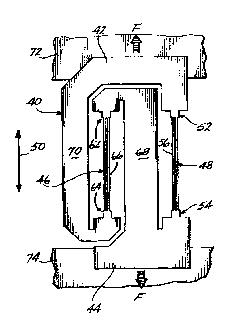Some of the information on this Web page has been provided by external sources. The Government of Canada is not responsible for the accuracy, reliability or currency of the information supplied by external sources. Users wishing to rely upon this information should consult directly with the source of the information. Content provided by external sources is not subject to official languages, privacy and accessibility requirements.
Any discrepancies in the text and image of the Claims and Abstract are due to differing posting times. Text of the Claims and Abstract are posted:
| (12) Patent Application: | (11) CA 2010962 |
|---|---|
| (54) English Title: | UNITARY PUSH-PULL FORCE TRANSDUCER |
| (54) French Title: | TRANSDUCTEUR DE FORCE SYMETRIQUE MONOBLOC |
| Status: | Deemed Abandoned and Beyond the Period of Reinstatement - Pending Response to Notice of Disregarded Communication |
| (51) International Patent Classification (IPC): |
|
|---|---|
| (72) Inventors : |
|
| (73) Owners : |
|
| (71) Applicants : |
|
| (74) Agent: | RICHES, MCKENZIE & HERBERT LLP |
| (74) Associate agent: | |
| (45) Issued: | |
| (22) Filed Date: | 1990-02-27 |
| (41) Open to Public Inspection: | 1990-08-27 |
| Examination requested: | 1990-02-27 |
| Availability of licence: | N/A |
| Dedicated to the Public: | N/A |
| (25) Language of filing: | English |
| Patent Cooperation Treaty (PCT): | No |
|---|
| (30) Application Priority Data: | ||||||
|---|---|---|---|---|---|---|
|
UNITARY PUSH-PULL FORCE TRANSDUCER
Abstract of the Invention
A push-pull force transducer comprising a unitary body (40) formed from a
crystalline substrate. The body comprises first and second mounting elements
(40, 42) for mounting the force transducer to first and second structures (72, 74),
and first and second force sensing elements (46, 48) connected to the mounting
elements. Each force sensing element has first and second ends, a line extendingfrom the second to the first end defining a force sensing axis for the force sensing
elements. The force sensing elements are oriented with their force sensing axes
parallel to and aligned with one another. The first force sensing element has its
first end connected to the second mounting element and its second end connected
to the first mounting element. The second force sensing element has its first end
connected to the first mounting element and its second end connected to the
second mounting element. Also described are embodiments utilizing strain relief
flexures and an embodiment featuring a leveraged design..
Note: Claims are shown in the official language in which they were submitted.
Note: Descriptions are shown in the official language in which they were submitted.

2024-08-01:As part of the Next Generation Patents (NGP) transition, the Canadian Patents Database (CPD) now contains a more detailed Event History, which replicates the Event Log of our new back-office solution.
Please note that "Inactive:" events refers to events no longer in use in our new back-office solution.
For a clearer understanding of the status of the application/patent presented on this page, the site Disclaimer , as well as the definitions for Patent , Event History , Maintenance Fee and Payment History should be consulted.
| Description | Date |
|---|---|
| Inactive: IPC expired | 2023-01-01 |
| Inactive: IPC expired | 2023-01-01 |
| Inactive: IPC from MCD | 2006-03-11 |
| Inactive: IPC from MCD | 2006-03-11 |
| Inactive: IPC from MCD | 2006-03-11 |
| Inactive: IPC from MCD | 2006-03-11 |
| Inactive: IPC from MCD | 2006-03-11 |
| Inactive: IPC from MCD | 2006-03-11 |
| Inactive: IPC from MCD | 2006-03-11 |
| Inactive: IPC from MCD | 2006-03-11 |
| Application Not Reinstated by Deadline | 1992-09-01 |
| Time Limit for Reversal Expired | 1992-09-01 |
| Deemed Abandoned - Failure to Respond to Maintenance Fee Notice | 1992-02-27 |
| Inactive: Adhoc Request Documented | 1992-02-27 |
| Application Published (Open to Public Inspection) | 1990-08-27 |
| Request for Examination Requirements Determined Compliant | 1990-02-27 |
| All Requirements for Examination Determined Compliant | 1990-02-27 |
| Abandonment Date | Reason | Reinstatement Date |
|---|---|---|
| 1992-02-27 |
Note: Records showing the ownership history in alphabetical order.
| Current Owners on Record |
|---|
| SUNDSTRAND DATA CONTROL, INC. |
| Past Owners on Record |
|---|
| BRIAN L. NORLING |